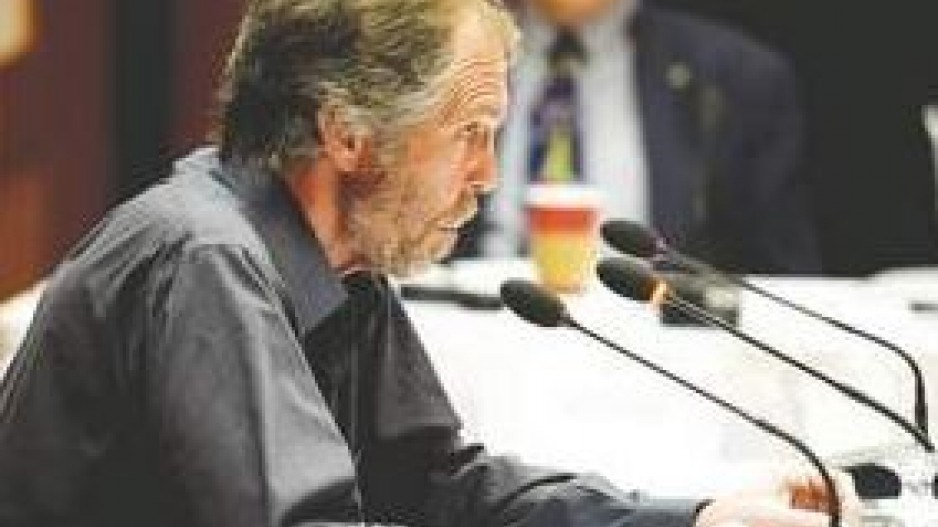Kwadacha First Nation has not yet taken a position on BC Hydro's proposed Site C dam but a representative outlined several concerns in a presentation to the joint review panel during public hearings December 19 in Prince George.
Speaking on behalf of Kwadacha Chief Donny Van Somer, who was snowed in and unable to attend the hearing, advisor John Lawson said the band does not want a repeat of the turmoil created when the W.A.C. Bennett Dam was built in the late 1960s.
The main reserve for the 500-member band is at Fort Ware north of Williston Lake, the massive manmade reservoir created by the dam and the impact on the Kwadacha was "almost entirely negative and even disastrous," Lawson said.
Much of the Kwadacha's traditional homeland disappeared, forcing members to relocate further to the north – Fort Ware is at the confluence of the Fox, the Kwadacha and Finlay rivers about 570 kilometres north of Prince George – and they were left isolated without road service and access to basic medical and community services and outside employment.
"A particular sad irony" is that although the Bennett and the subsequent Peace Canyon dam supply about a third of the province's electrical power, Kwadacha went without community power for many years and became a BC Hydro customer only this year.
Lawson said it took until 1998 for BC Hydro to acknowledge responsibility and a further 10 years to work out a less-than-perfect settlement agreement.
It included a one-time $15-million payment of which $13-million went into an endowment and an annual payment of $1.5 million per year from BC Hydro.
"Kwadacha has had a very long and difficult past with Hydro," Lawson said. "Its people are justifiably concerned about the proposals for a new project. Nevertheless, it must move forward and is working with Hydro and others in the best ways it can to produce a positive change."
Lawson raised four concerns specific to Site C:
- that possible changes to the water level in Williston Reservoir will exacerbate problems with dust, erosion and log jams. Although Kwadacha understands that BC Hydro has no intention to manipulate the level, Lawson said it wants a clear statement of the condition from the utility;
- that BC Hydro's study and analysis of the project's impact on the area's ungulate and large carnivore populations is too narrow and should be broadened to consider the larger region and over a longer timeline. Kwadacha also worries the flooding Site C will create on the Peace River will cause hunters and other recreationalists to encroach on its territory and put greater pressure on the game in that area, Lawson said;
- that the cost of already expensive supplies and services to Kwadacha will rise further while their availability declines as businesses focus on servicing the Site C project;
- that cumulative effects of the large industrial projects that will follow in northern B.C. will require more in-depth analysis, consultation with First Nations and more effective response mechanisms.
"First Nations will not agree or merely sit by and watch as they see their homelands inevitably disappear or be changed irreparably by actions and decisions of others who have no investment or interest in the area beyond short-term unemployment."
The project must also present Kwadacha with not just employment opportunities but business opportunities by giving First Nations a chance to effectively compete for and secure significant contracts, Lawson said.
"There is an unfortunate but sometimes accurate saying heard among First Nation people – that First Nation business often means two guys with a chainsaw," Lawson said. "That can't be the case with this project, Kwadacha expects more and expects better."
Kwadacha will neither support Site C nor pursue economic advantages at the expense of other First Nations and will support positions taken by Treaty 8 bands in northeast B.C., Lawson added.
Kwadacha will elaborate further during topic-specific hearings beginning in January.
In other presentations to the three-person Canadian Environmental Assessment Agency panel, BC Hydro representatives said the project will deliver a $3.2 billion boost to the province's gross domestic product in direct costs during Site C's construction period. The project will cost $7.9 billion but that total accounts for $1.5 billion in interest costs and $1 billion for inflation. As well, the turbines will come from out-of-province and there are other indirect costs not included in the $3.2 billion, the panel was told.
The panel heard from a handful of other speakers, split equally between those for and against the project.
Keith Sashaw, chief executive officer of the B.C. Association of Consulting Engineering Companies, said the project, if approved, will deliver stable, dependable power to major industrial projects on the books.
Lynn Chapman, who traveled to Prince George from Roberts Creek on the Sunshine Coast to make her presentation, urged rejection and provided a slide show of the area that would be impacted by flooding as a result of Site C.
BC Hydro says the dam would add 5,100 gigawatt hours of annual energy and 1,100 megawatts of dependable capacity to the system but critics say it would come at significant environmental cost as it would create an 83-kilometre long reservoir behind the structure.




